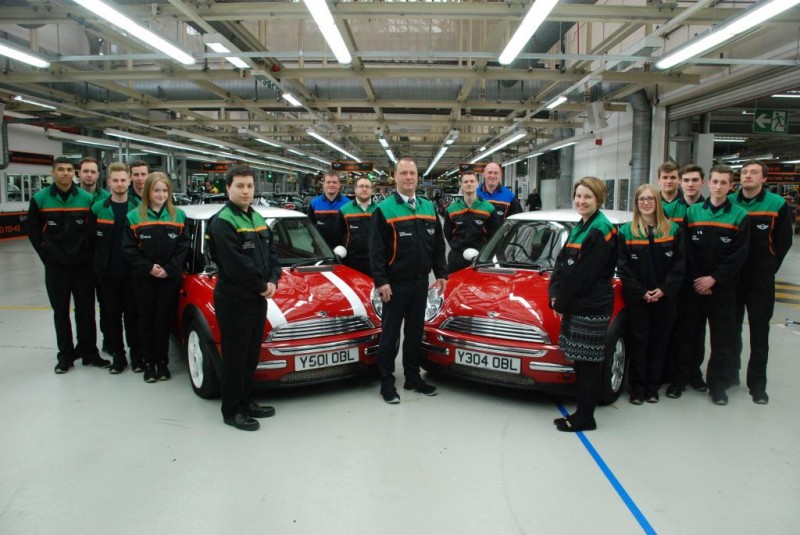From BMW Group PressClub UK:
Plant Oxford today celebrates 15 years since the first new MINIs rolled off the production line on 26 April, 2001.
The BMW Group, which is marking its centenary year in 2016, acquired the plant in 1994 and relaunched the brand in 2001 with the debut of the new MINI Hatch.
Since then more than 2.5 million MINIs have been produced in Oxford, with the three million milestone expected to be hit later this year. 80 per cent of the cars made here are exported to more than 110 countries around the world.
The 2001 MINI launch was the reinvention of a British motoring icon, which generated headlines around the world. As well as making the news, the car was subsequently recognised with several industry awards after it went on sale. This included being voted ‘Car of the Year’ in 2001 by leading UK weekly car magazine, Auto Express. Impressed by the car’s driving abilities, quality levels and safety features, the magazine praised the fact that the classic Mini’s DNA was “unmistakable” in the new car.
Sales of MINI, both in the UK and internationally, have gone from strength to strength over the last 15 years. In its first year nearly 40,000 MINIs were sold worldwide. By 2015 this number had risen to nearly 340,000, with more than 63,000 sold to customers in the UK – the highest since the brand’s relaunch.
Frank Bachmann, Managing Director of MINI Plant Oxford, said: “MINI is an iconic British brand that has made a remarkable journey over the past 15 years. In that time we’ve more than doubled our capacity and gone from producing just one model to an entire range of MINIs that have proved hugely popular with customers around the world. Making 1,000 high-quality cars to individual order each day is a huge challenge but we succeed in doing so because of the passion and expertise of our workforce. Today, we celebrate what’s been achieved so far and look forward to an even brighter future here in Oxford – the heart of MINI production.”
The plant’s automotive history dates back to 1913 when the great designer, entrepreneur and philanthropist William Morris (later Lord Nuffield), produced its first car, a “Bullnose” Morris, near today’s present state-of-the-art MINI production facility. The classic Mini was produced at Oxford from 1959 until 1968 with a peak output of 94,889 cars during 1966/67.
Today, more than 4,500 people are employed at the site in Cowley, which manufactures around 1,000 cars a day, including three and five door MINIs, the MINI Clubman and its first all-wheel drive All4 model – and the high-performance MINI John Cooper Works.
Three UK plants have had a part to play in MINI production – Hams Hall near Birmingham makes engines, Swindon produces body pressings and sub-assemblies for MINI, and this all comes together at Oxford with body shell production, paint and final assembly. Together these plants have helped to generate and sustain employment for thousands of people directly and indirectly though the wider supply chain and retailers.
Between 2012 and 2015 BMW Group invested £750 million at the plants, taking investment in UK production to £1.75 billion since 2000. At Oxford this has included a state-of-the-art paintshop, a high-technology body building facility, a new final assembly area, a new logistics centre, Quality and Engineering Centre and the MINIcademy, where the plant’s apprentices are trained.
Joining Technician Chris Wherritt is one of 22 current plant associates who began their careers as apprentices in 2001.
Chris said: “Starting my apprenticeship straight from school was exciting and nerve-wracking at the same time. After all, 2001 was a big year for the plant — I knew it would be a big change but I wasn’t aware at the time just how successful the new MINI was going to be. I already had a position secured for after my apprenticeship when the 2001 MINI rolled off the production line, and the launch was all over the news — that’s when I knew both the MINI and I had a bright future ahead of us.”
Helen Evans, currently in her first year as an engineering apprentice, said: “I’ve always been fascinated by cars and so seeing MINI’s transformation while still paying homage to the original has been really interesting. It’s been a great experience working at the plant so far and I’m really excited to see how my career with MINI will evolve in the future.”
The first MINIs – which were registered with ‘Y’ prefixed number plates – are now considered by many enthusiasts and fans of the brand to be modern classics.
MINI enthusiast Tanya Field, whose husband Jason works at the plant in IT, is working to set up a new club – Y REGister – to bring together owners of MINIs made in Oxford in 2001.
Tanya said: “Today is a wonderful milestone for MINI Plant Oxford. The first MINIs are 15 years old and are now becoming modern classics and are increasingly collectable. The creation of the Y REGister shows the growing interest in these MINIs and the heritage of the modern MINI. As someone who’s passionate about the plant’s heritage, this is something that’s really important to me.”
Editor’s notes
- MINI is the only car in the segment that offers Head Up Display, which projects important information into the driver’s line of vision, thus eliminating the need to take their eyes off the road.
- The John Cooper Works Hatch has the best power to weight ratio in the segment as well as the highest top speed and the best acceleration of a non 4-wheel drive car in the segment.
- MINI Cooper D is the fastest accelerating car to be sub 100kg / km in the segment.
- MINI Touch Controller enables users to draw in postcodes using their fingertips.
